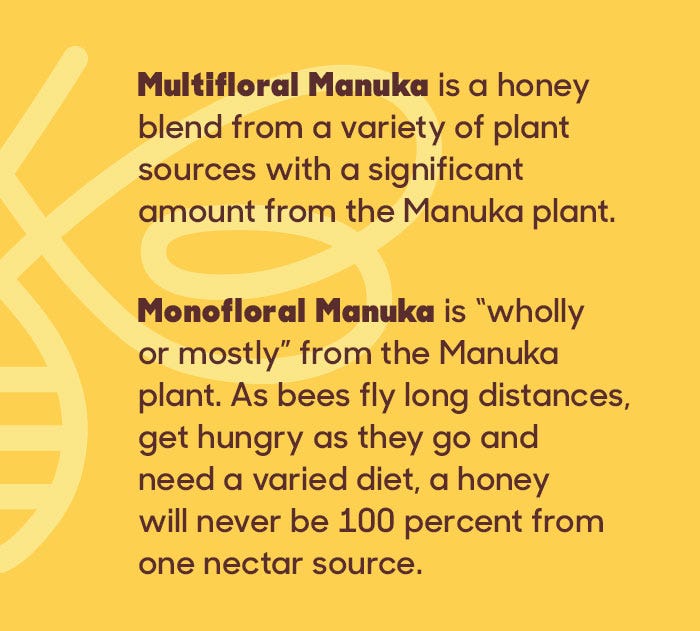Understanding purity in Manuka honey
This vibrant ingredient has a range of health benefits that your customers will love. Here's how to identify a quality product.
October 12, 2018

Sponsored Content
Haven’t you heard? There’s a different kind of honey in town. And there’s good reason that this potent New Zealand variety, known for supporting everything from immunity to digestion, has become a prized wellness product in the U.S. in recent years. Today, best practices are helping to ensure that authentic products make their way into consumers’ hands, and when it comes to Manuka, knowing what to look for is key to stocking a quality product.
Luckily, the New Zealand government is helping to ensure that legitimate products enter the U.S. market. In response to issues around adulteration in recent years, it enacted quality guidelines and began testing all honey to be exported and labeled as authentic Manuka honey. Add to that the work that brands and retailers are doing to elevate the industry as a whole and Manuka is proving its worth as a wellness staple. Here’s a snapshot of what to know about this all-star ingredient—and how to ensure your customers are getting what they pay for.
Manuka magic
While Manuka may be new to many of us, that’s not the case in New Zealand, where it has a rich history with native Maori people who have used the honey made from its nectar medicinally for centuries (“Manuka” is a Maori word for a type of tea tree plant, leptospermum scoparium, that grows in New Zealand; the honey is produced from the nectar of this plant). In fact, Manuka’s roots aren’t just in New Zealand; it has been used for its healing properties worldwide since ancient times. Evidence of the golden stuff appears in rock paintings and on papyrus. It’s mentioned in the Bible, Koran and Torah.

While the FDA has approved it for use in wound dressings, which is still one of its uses, new research and consumer preferences are fueling its use for a range of the most common consumer health concerns. How should customers take it? While Manuka has a pretty strong flavor, it’s also quite versatile. A spoonful of the naturally sweet ingredient can be mixed into yogurt or oatmeal, post-workout smoothies, wellness tonics or on toast with nut butter. In other words, the foreign ingredient doesn’t have to feel so foreign.
What makes a quality product?
Even if you carry it in your store, you may not be fully versed in how to identify a quality product, which is becoming increasingly important. Luckily, the New Zealand government is already doing part of the work for you. In 2014, responding to international trading partners about the authenticity of Manuka honey sold in the world market, the New Zealand government began a three-year scientific quest for a definition of authentic Manuka honey to use in order to regulate export. Researchers from New Zealand’s MPI collected and tested more than 800 honey samples, representing more than 20 different New Zealand honey types from seven production years. They ran approximately 10,000 tests and 1,000 statistical analyses, soliciting help from a dozen scientific organizations. Three independent international experts reviewed the analyses. The new regulations kicked in Feb. 5, 2018.
So how does a company meet the standard? All Manuka honey is tested against five markers (four chemicals and one DNA marker) for authenticity. In response to industry feedback, MPI increased the required level of methoxyacetophenone, a chemical unique to Manuka plants, to make it harder to counterfeit.
“Our reputation for honey production and export rests on the integrity of our products and the credibility of our systems,” says Steve Hathaway, director science and risk assessment, regulation and assurance of the Ministry for Primary Industries (MPI). “The science definition for Manuka honey is essential to maintain New Zealand’s premium position in overseas markets. It will also help the continued growth of our export honey industry.” He notes that international regulators need to have the assurance that the New Zealand Manuka honey they’re selling to consumers is genuine.” “If not, our access to markets could be put at risk or we may lose the premium prices our bee products command overseas.” The new regulations have also strengthened traceability throughout the honey supply chain, he adds.
The new regulatory definition describes two levels of Manuka honey: multifloral and monofloral. Multifloral or monofloral certifications have different minimum levels for two of the five markers.

Label lowdown
Work with companies that can explain the traceability and supply chain behind their products. And check out these certification and testing systems to vet for product quality.
New Zealand FernMark: This certifies that the product was produced and packaged in New Zealand, which means that it had to pass the MPI standard to be exported to the U.S.
The KFactor System: This methodology is used by the Wedderspoon company to grade Manuka honey. It goes beyond the MPI regulations for Manuka honey and focuses on five key factors ensuring the holistic quality of the product: produced and packaged in New Zealand; free of antibiotics, glyphosate and pesticides; traceable; raw and unpasteurized; and Non-GMO Project Verified.
These familiar labels and terms may also appear on Manuka honey.

Non-GMO Project Verified
Glyphosate Residue Free
Kosher
Halal
Safe Quality Food (SQF) Level 3 Certified Production Facility
Raw, Unpasteurized
You May Also Like


